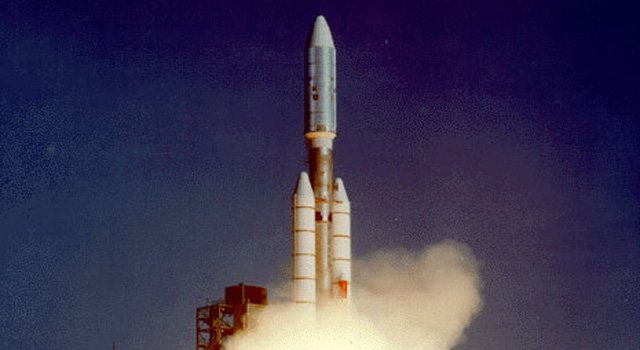Fast Facts

Launch
Voyager 2 launched on August 20, 1977, from Cape Canaveral, Florida aboard a Titan-Centaur rocket. On September 5, Voyager 1 launched, also from Cape Canaveral aboard a Titan-Centaur rocket.
Planetary Tour
Between them, Voyager 1 and 2 explored all the giant planets of our outer solar system, Jupiter, Saturn, Uranus and Neptune; 48 of their moons; and the unique system of rings and magnetic fields those planets possess.
Closest approach to Jupiter occurred on March 5, 1979 for Voyager 1; July 9, 1979 for Voyager 2.
Closest approach to Saturn occurred on November 12, 1980 for Voyager 1; August 25, 1981 for Voyager 2.
Closest approach to Uranus occurred on January 24, 1986 by Voyager 2.
Closest approach to Neptune occurred on August 25, 1989 by Voyager 2.
Most Distant Spacecraft
The Voyager spacecraft are the third and fourth human spacecraft to fly beyond all the planets in our solar system. Pioneers 10 and 11 preceded Voyager in outstripping the gravitational attraction of the Sun but on February 17, 1998, Voyager 1 passed Pioneer 10 to become the most distant human-made object in space.
The Golden Record
Both Voyager spacecrafts carry a greeting to any form of life, should that be encountered. The message is carried by a phonograph record - -a 12-inch gold-plated copper disk containing sounds and images selected to portray the diversity of life and culture on Earth. The contents of the record were selected for NASA by a committee chaired by Carl Sagan of Cornell University. Dr. Sagan and his associates assembled 115 images and a variety of natural sounds. To this they added musical selections from different cultures and eras, and spoken greetings from Earth-people in fifty-five languages.
Present Status
As of April 2020, Voyager 1 is at a distance of 22.3 billion kilometers (149.0 AU) from the Sun.
Voyager 2 was at a distance of 18.5 billion kilometers (123.6 AU).
Voyager 1 is escaping the solar system at a speed of about 3.6 AU per year.
Voyager 2 is escaping the solar system at a speed of about 3.3 AU per year.
There are currently five science investigation teams participating in the Interstellar Mission. They are:
1. Magnetic field investigation
2. Low energy charged particle investigation
3. Cosmic ray investigation
4. Plasma Investigation (Voyager 2 only)
5. Plasma wave investigation
Five instruments onboard the Voyagers directly support the five science investigations. The five instruments are:
1. Magnetic field instrument (MAG)
2. Low energy charged particle instrument (LECP)
3. Cosmic ray instrument (CRS)
4. Plasma instrument (PLS)
5. Plasma wave instrument (PWS)
One other instrument is collecting data but does not have official science investigation associated with it:
6. Ultraviolet spectrometer subsystem (UVS), Voyager 1 only
Termination Shock
Voyager 1 crossed the termination shock in December 2004 at about 94 AU from the Sun while Voyager 2 crossed it in August 2007 at about 84 AU. Both spacecraft are now exploring the Heliosheath.
The Heliosphere
The heliosphere is a bubble around the sun created by the outward flow of the solar wind from the sun and the opposing inward flow of the interstellar wind. That heliosphere is the region influenced by the dynamic properties of the sun that are carried in the solar wind--such as magnetic fields, energetic particles and solar wind plasma. The heliopause marks the end of the heliosphere and the beginning of interstellar space. Voyager 1, which is traveling up away from the plane of the planets, entered interstellar space on Aug. 25, 2012. Voyager 2, which is headed away from the sun beneath the plane of the planets, reached interstellar space on Nov. 5, 2018.
